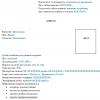Clindamycin capsules: instructions for use. Clindamycin - what is it and why, forms, action Clindamycin course of treatment
Content
The twentieth century presented antibiotics to mankind as a way to get rid of many infections. Today people are faced with another problem: the side effects of some synthesized antibiotics cast doubt on the appropriateness of their use in medicine. Clindamycin is a narrow-spectrum antibiotic that can cope with severe infectious diseases. What are the consequences of using it? It is worth understanding all the pros and cons of treatment with this drug.
Instructions for the use of Clindamycin
In therapy infectious diseases the use of narrowly targeted antibiotics is justified, since over time, resistance of pathogenic microorganisms to antiviral drugs wide range actions. Clindamycin is a semi-synthetic lincosamine antibiotic used to treat infections caused by anaerobic bacteria. This drug is a derivative of Lincomycin, but has better pharmacological characteristics.
Composition and form of release
Clindamycin is produced in different forms, which contributes to its widespread therapeutic use. The drug is packed in cardboard boxes with:
- 8 capsules in a blister. The package contains 2 blisters.
- Solution for intramuscular and intravenous administration... Ampoules are packaged in 5 pieces in two cell stands.
- Granules for syrup preparation - in a glass bottle.
- Vaginal cream - in an aluminum tube with 7 single applicators.
- Vaginal suppositories - 3 suppositories.
- Gel for external use - in an aluminum tube.
This antibiotic is developed on the basis of Lincomycin - one of its hydroxyl groups has been replaced by chlorine. The instruction indicates the following composition of the medicine:
|
Release form |
Content Description |
For what age group of patients |
Volume of substance in the form (ml) / (g) |
Active substance (mg) |
Supporting components |
|
Gelatin capsule |
white powder |
adults |
clindamycin hydrochloride: 75, 150 and 300 |
talc, lactose monohydrate, corn starch, magnesium stearate |
|
|
15% colorless solution |
clindamycin phosphate: 300, 600, 900 |
benzene alcohol, water, edetate disodium |
|||
|
flavored powder |
75 mg of clindamycin palmitate hydrochloride in 5 ml |
||||
|
2% vaginal cream |
adults |
20 mg clindamycin phosphate per 1 g cream |
sodium benzoate, Castor oil, propylene glycol, emulsifier EM 3398, macrogol (polyethylene oxide 1500) |
||
|
vaginal |
adults |
10mg clindamycin phosphate in 1g suppository |
solid fat, monoglycerides |
||
|
adults |
10 mg clindamycin phosphate per 1 g of gel |
water, carbomer, sodium hydroxide, allantoin, methylparaben, propylene glycol. |
pharmachologic effect
The antibiotic Clindamycin is active against pneumocysts, toxoplasma, anaerobic bacteria, except for strains resistant to antibiotics of the linkiside group. It is different high degree penetration medicinal substance to the site affected by the infection, regardless of the time the patient is taking the drug. Indispensable in cases of intolerance to patients with penicillins. It can be used in combination with other drugs that fight gram-negative bacteria.
This antibiotic is widely used for the treatment of infections of soft and bone tissues, joints, respiratory tract infected with the following pathogenic bacteria:
|
Name |
|||
|
Staphylococcus |
gram-positive aerobic |
skin infections, endocarditis, osteomyelitis, pneumonia |
|
|
Pneumococcus |
Streptococcus pneumoniae |
gram-positive anaerobic |
community-acquired pneumonia, otitis media, acute sinusitis, rhinitis, laryngitis, bronchitis, meningitis |
|
Corynebacteria |
Corynebacterium diphtheriae |
gram-positive immobile chopsticks |
diphtheria |
|
Mycoplasma |
anaerobes |
urethritis, vaginitis, adnexitis |
|
|
Chlamydia trachomatis |
Chlamydia trachomatis |
gram-negative non-motile coccobacilli |
urogenital chlamydia |
|
Clostridia |
Clostridium perfringens Clostridium tetani |
gram-positive, motionless anaerobic |
food poisoning, necrotizing enteritis, gas gangrene |
|
Frigalis bacteroids |
Bacteroides fragilis |
gram-negative anaerobic, immobile, capsule-forming |
peritonitis, abscesses, endometritis, Reiter's disease |
|
Melaningenicus bacteroids |
Bacteroides melaningenicus |
purulent-septic processes |
Pharmacodynamics and pharmacokinetics
Clindamycin penetrates well into all fluids, soft tissues of the body and bones. The drug inhibits the synthesis of proteins in the cells of pathogenic microorganisms, exhibiting bacteriostatic and bactericidal effects. There are a number of bacteria that are resistant to this antibiotic:
|
Name |
Latin name |
Characterization of microorganisms |
Diseases caused by these bacteria |
|
Neisser's gonococcus |
Neisseria gonorrhoeae |
gram-negative diplococci |
gonorrheal vulvovaginitis |
|
Candida albicans |
Candida albicans |
saprophytic yeast |
candidiasis |
|
Vaginal Trichomonas |
Trichomonas vaginalis |
unicellular flagellate bacterium |
urogenital trichomoniasis |
|
Enterococcus |
gram-positive anaerobic |
meningitis, bacteremia, dysbiosis |
|
|
Clostridia |
Clostridium tertium Clostridium sporogenes |
gram-positive spore-bearing |
botulism, tetanus, gas gangrene, Clostridial foodborne infection |
|
Herpes simplex |
The maximum concentration of the medicinal substance in the blood with oral administration is observed faster than with intramuscular administration. The active substance enters the bloodstream 1-3 hours after taking (administering) the drug. Having reached the infected area, it is retained in the body for about 12 hours, while almost 90% of the substance binds to the proteins of pathogenic microorganisms. Clinical studies no accumulation of active substances of the drug was detected. It is processed by the liver. Metabolites are excreted completely after 4 days with urine, bile and feces.
Indications for use
Clindamycin is used to treat infectious diseases caused by pathogenic microorganisms sensitive to the active substance of the drug:
- abdominal cavity and intestines (abscess, peritonitis);
- oral cavity (periodontal abscess);
- urogenital area (bacterial vaginosis, chlamydia, vaginal dysbiosis, vaginal candidiasis, endometritis);
- infections of the throat, ear, nose, upper and lower respiratory tract (otitis media, tonsillitis, pharyngitis, sinusitis, pleural empyema, diphtheria, scarlet fever, pneumonia, etc.);
- skin and soft tissues (felon, boil, impetiglo, erysipelas, infected wounds);
- joint and bone infections (septic arthritis, osteomyelitis);
- tropical malaria;
- infectious inflammation the inner lining of the heart (endocarditis);
- anaerobic septicemia (blood poisoning).

Method of administration and dosage
Antibiotic treatment takes place strictly under the supervision of a physician. The choice of the form of the drug, its dosage and time of administration depend on:
- the age of the patient;
- his health;
- areas of infection of the body;
- the severity of the course of the disease;
- the sensitivity of the pathogen to the active substance of the drug.
Cream
For vaginal infections, an antibiotic cream is prescribed for intervaginal use. The disposable measuring applicator (supplied) is attached to the tube of cream and filled. To do this, press on the tube without pulling the piston of the applicator. One dose of the drug (5 mg) is injected into the vagina 1 time per day before bedtime. The duration of treatment is 7 days.
Solution
For adults, solution for intramuscular (intravenous) injection is used 2 times a day, 300 mg. With a severe course of the disease, it is possible to increase the daily dose of the drug to 2700 mg. It is divided into 3-4 injections. In this case, a single administration should not exceed 600 mg. Children from 3 years old are prescribed 15-25 mg per 1 kg of weight and divided in equal parts into 3-4 injections. At severe infections the dosage for children is increased to 40 mg per day.
For intravenous use, the drug is diluted with a solution of 0.9% sodium chloride or 5% dextrose to a concentration of no more than 6 mg / ml. The resulting solution is injected drip from 10 to 60 minutes (depending on the dose). Maximum allowable rate single intravenous injection - 1.2 g. Subject to an 8-hour break between droppers, patients with renal (hepatic) insufficiency are prescribed the usual dosage of this antibiotic.
Capsules
Children under 12 years old are not prescribed an antibiotic in the form of capsules. The dosage for patients of other age groups is as follows:
Candles
Suppositories with clindamycin are used for treatment 1 time per day before bedtime. In the supine position, it is necessary to lead the suppository deep into the vagina. The course is 3-7 days.
Gel
Inflammatory processes on the skin with bacterial infections are accompanied by a rash in the form of acne. At skin diseases the doctor may prescribe capsules and a gel containing an antibiotic for concurrent treatment. A gel-like ointment with clindamycin is used for external use. The gel is applied in a thin layer on pimples and areas with urge rash after cleansing the skin.

special instructions
Antibacterial drugs disrupt the normal intestinal flora. Pseudomembranous colitis can develop during the use of this antibiotic and 3 weeks after the course. It is necessary to treat diarrhea and other dangerous symptoms during the specified period as a manifestation of this diagnosis. In elderly people, when using antibiotics, pseudomembranous colitis manifests itself more often and is more severe. For the treatment of colitis, ion exchange resins, vancomycin or metronidazole are prescribed.
The use of this antibiotic can lead to a significant growth of pathogenic bacteria that are insensitive to it. Depending on the type of overgrown infection, it is necessary to carry out the necessary therapy. When using high doses of this antibiotic, it is very important to control the level of active substance in blood plasma. Before prescribing vaginal suppositories or cream to patients, it is necessary to conduct a laboratory analysis for the presence of microorganisms resistant to Clindamycin, which cause vulvovaginitis.
Women during treatment with this antibiotic should avoid sexual intercourse (the active component of the drug reduces the strength of latex and rubber contraceptives). Do not use intravaginal tampons during menstruation during the treatment period. The antibiotic is not compatible with alcohol. Do not use the product in the form of a gel after using scrubs to avoid excessive skin irritation.
Clindamycin during pregnancy
The antibiotic easily penetrates the fetus through the placenta, therefore, it is not prescribed orally and parenterally to pregnant women. The effect of the drug in the form of an ointment on an increase in congenital abnormalities of the fetus during intravaginal use by pregnant women in the 2nd and 3rd trimester was not recorded. This drug should be used in exceptional cases as directed by the attending physician and under his constant supervision.
In childhood
For children under 8 years of age, an oral antibiotic is prescribed in the form of a syrup. The granular preparation is intended for self-preparation of syrup (suspension). Fill the bottle with granules with 60 ml of water and shake well. The calculation of the dose of the drug is made based on the body weight and age of the child. The daily dose of syrup for children over 1 month old is 8-25 mg per kilogram of weight, divided into 4 doses. The minimum dose for children weighing less than 10 kg is 37 mg (1/2 teaspoon) every 8 hours.
This antibiotic is administered parenterally to children:
|
Child's age |
Dose (mg / kg / day) |
Multiplicity of introduction |
|
up to 1 month |
||
|
from 1 month |
Drug interactions
Clindomycin, when interacting with other drugs, sometimes has a negative effect on the patient's body. This must be taken into account when prescribing the drug in complex therapy:
- Does not combine with barbiturates. Joint use of drugs is prohibited.
- Strengthens muscle relaxation caused by n-anticholinergics.
- Shows antagonism to Erythromycin and Chloramphenicol.
- Joint use with Fortum is toxic to the kidneys.
- Enhances the action of aminoglycosides.
- With antidiarrheal drugs, it can lead to pseudomembrane colitis.
- Depressing respiration (up to apnea) when used in combination with anesthetic drugs of the opium series.
- Does not combine with other vaginal medications.

Side effects
When using Clindomycin gel for external use, an allergic reaction is possible. To avoid this, before using the medicine, it is necessary to test for the individual tolerance of the components of the drug. It is necessary to lubricate the inner fold of the elbow with gel. If after 2 hours there is no redness or itching, you can use the gel for treatment. When using an antibiotic in the form of a vaginal cream, undesirable effects are possible:
- Urogenital area: irritation of the mucous membrane of the vagina and vulva, itching, candidiasis, vulvovaginitis, Trichomonas vaginitis, violation of the menstrual cycle, uterine bleeding, endometriosis, dysuria.
- General condition: abdominal pain, flatulence, nausea, vomiting, diarrhea, upper respiratory tract infections, bad breath, dizziness.
- Skin: urticaria, itching.
Taking this antibiotic is accompanied by side effects when used orally and parenterally. Undesirable effects can occur in the following body systems:
- Digestion: dysbiosis, pseudomembranous enterocolitis, jaundice, esophagitis.
- Hematopoiesis: neutropenia, thrombocytopenia, leukopenia.
- Cardiovascular system: decrease blood pressure, dizziness.
- Covering tissue: skin rash, dermatitis, eosinophilia, urticaria.
- Others: superinfection.
Overdose
An unjustified increase in the dose of Clindamycin (in the form of capsules, injections) causes nausea, vomiting, and abdominal pain. There is no specific antidote. In case of an overdose, symptomatic treatment is used. For severe symptoms, use epinephrine, antihistamines. To prevent overdose, doctors control the amount of the active substance of this drug in the plasma and adjust the dose based on laboratory test data.
Contraindications
Clindamycin should not be given to nursing mothers. It is forbidden to use the drug when:
- renal and hepatic failure;
- ulcerative colitis;
- bronchial asthma;
- diarrhea;
- lactase deficiency;
- asthenic bulbar palsy;
- individual intolerance to the components of the drug;
- pregnancy.

Terms of sale and storage
Clindamycin in all forms is available from pharmacies with a doctor's prescription. Store in a dry, dark place out of reach of children. Shelf life of this medicine in the form:
- solution for intravenous and intramuscular administration - 2 years from the date of manufacture (indicated on each ampoule and on the packaging);
- capsules - 3 years;
- cream - 2 years;
- candles - 3 years.
Analogs
If the use of Clindamycin is impossible for some reason, the doctor prescribes its analogs:
- Klindatop. Gel for external use for the treatment of mild to moderate forms of acne.
- Klimycin. Available in the form of granules for preparing baby syrup and injection solution.
- Dalatsin. Available in the form of capsules, injection solution, granules, gel, vaginal cream and suppositories.
- Zerkalin. A drug for the treatment of acne.
Clindamycin price
Pharmacies within Moscow dispense the drug at prices that differ slightly from each other. The cost of the medicine different forms issue is indicated in rubles:
|
Release form |
Pharmacy name |
|
|
Capsules |
||
|
Solution 2 ml |
||
|
Alexandrovskaya |
||
|
Kremlin |
||
|
WestWEST |
||
|
Lakes in Medvedkovo |
||
|
Lighthouse on Mikhailovo |
||
|
Planet Health |
Clindamycin - how the medicine works; applications, forms and uses. Which diseases respond most successfully. When to be careful. Patient risk groups - if contraindicated. How to choose the most suitable shape
Clindamycin is an antibiotic, a group of lincosamides.
It is used to treat severe infections, including skin, caused by anaerobic and gram-positive cocci. The drug is one of the most effective, especially for stubborn skin diseases. In such cases, it is important to administer antibiotics, side effects which do not outweigh the benefits. Sometimes some bacterial strains are quite resistant and do not respond to common broad-spectrum antibiotics. Therefore, it makes sense to use clindamycin, which targets specific pathogen groups, primarily anaerobic bacteria.
What is clindamycin? Indications
When administered orally, the antibiotic clindamycin is very rapidly digested through gastrointestinal tract... The therapeutic concentration in the blood is maintained for 8-12 hours. Metabolic breakdown occurs in the liver; decomposition products are discharged through urine and faeces within four days.
Clindamycin tablets and oral solutions are used in infections of the respiratory tract, genitourinary systems, inflammation of the abdominal cavity, skin and soft tissues, diphtheria and scarlet fever, osteomyelitis and endocarditis. Gel and cream formulations are applicable, for example, to bacterial vaginosis. The form of suppositories is also known.
With infected joints
The drug is one of the most suitable for infected joints, osteomyelitis and septic arthritis. It can be recommended in the form of tablets or capsules of 150, 300 or 600 mg or injectable form. For oral administration the daily dose ranges from 600 to 1800 mg, divided equally into 2-4 doses. The prescriber may also recommend this medication to children, calculating the daily intake according to the small patient's weight and the exact condition. In harsh environments, initial infection control may be by intravenous infusion or intramuscular injection of clindamycin.
The practitioner must be confident that pathogens respond to clindamycin
Joints can become infected by trauma or surgery. An inflammatory process occurs, manifested by pain, redness and swelling, fever - locally or throughout the body. Antibiotic treatment is mandatory and the choice of antibiotic depends on the type of pathogen. Clidandomycin is one possible solution; the drug can also be taken prophylactically to avoid such infections - for example, after surgery involving bones and joints. The duration of prophylaxis is usually 10 days. Long-term therapy is sometimes required; if clindamycin is given in one form or another for more than three weeks, it should be done with liver and kidney function monitoring.
For ears, nose and throat. In case of sinusitis
For diseases of the ear, throat or nose, and acute forms sinusitis, antibiotics can be given in combination with analgesics. However, the choice of antibiotic must be made after being examined by a specialist: in fact, he is assessing whether the condition really requires antibiotic therapy. For example, when working in the middle ear, the work is quite serious; complications are possible, especially if the embarrassment has already begun. The use of clindamycin makes sense if it is a bacterial infection. Sometimes infections in these organs are the result viral disease, which is subsequently aggravated by a bacterial infection. The usual form is oral pills or capsules.
For teeth, gums and periodontal disease
Inflammation of the tooth or dental crown may also require clindamycin; this requires a doctor's recommendation. The infection can only be controlled for a few days, but longer therapy may be required. According to the individual needs of the patient, treatment can combine oral dosing of tablets or capsules and a switch to long-term use of a topical antibiotic for sore gums.
For respiratory infections. With bronchitis
Respiratory infections are often caused by viruses and are not known to be exposed to antibiotics. In the same time respiratory system a viral infection is usually at risk of supplementation and bacteria due to weakened immunity. Complications in such cases are bronchitis and bronchopneumonia. The use of Clindamycin in a dose and form appropriate for the individual patient can successfully control the infection within about ten days. Of course, this type of treatment should be recommended by a specialist, and your doctor may monitor your body's reactions to clindamycin.
Abdominal infections. With prostatitis
Infection of an organ located in the abdominal cavity or abdominal wall, requiring surgical treatment... These operations are high risk; The postoperative stage is associated with the risk of developing a new infection. For this reason, the use of antibiotics is required first with intramuscular or intravenous administration after the intervention, followed by oral administration for about 10 days.
 In the case of bacterial prostatitis, an inflammation of the prostate gland, the Clindamycin variant is effective, but a specialist diagnosis and treatment with this antibiotic must be made to recommend it. The problem can arise as a result of infection with chlamydia, this is also a reason to focus on clindamycin.
In the case of bacterial prostatitis, an inflammation of the prostate gland, the Clindamycin variant is effective, but a specialist diagnosis and treatment with this antibiotic must be made to recommend it. The problem can arise as a result of infection with chlamydia, this is also a reason to focus on clindamycin.
In gynecology. Chlamydia and staphylococcus
Unfortunately self-medication gynecological problems is a common practice with unpredictable consequences. Taking an antibiotic for back pain may be unnecessary and inappropriate if it is caused by a hormonal disorder.
With infected skin. For acne, rosacea
Clindamycin is successful remedy and in the treatment of skin infections - superficial and subcutaneous tissues. It also helps with cellulite by providing appropriate treatment to cleanse and renew the subcutaneous layer affected by fluids and toxins. For problems such as acne and rosacea, purulent rashes, and pustules, your doctor may recommend taking a pill or capsule and then continuing with a topical product like a gel or ointment. Important details: This is not a suitable drug for the treatment of adolescents under 14 years of age. The reason is the risk negative influence on the formation of bones in the skeleton and teeth.
Scarlet fever is sometimes referred to as a childhood disorder, but it is inherently painful as an experience and at risk of complications such as sinusitis, angina, or even meningitis. The antibiotic Clindamycin is effective and bactericidal for the staphylococcal agent; Typical symptoms are sore throat, painful itching rash, fever, decreased appetite, and swelling of the salivary glands.
Dangers and warnings
Allergic reactions are the first reason for the withdrawal of Clindamycin. The drug also does not apply to ulcerative enteritis, colitis, followed by antibiotics. Particular care is required when treating this antibiotic if the patient suffers from myasthenia gravis, liver or kidney disease. According to the pharmacological characteristics, these groups of patients can be treated with Clindamycin in a limited manner and under strict medical supervision. Children are a separate group, recommendations are newborns up to one month old, who cannot be treated with antibiotics.
Allergy
Like any antibiotic, Clindamycin is a drug that has a strong effect on the body and should be considered possible consequences his admission. Special attention is paid to possible allergic reactions such as skin problems, rashes and discomfort, swelling of the face and throat, difficulty in swallowing and breathing, anaphylactic shock. Even when this product is new to the patient, allergic reactions may be possible if he was treated with lincomycin.
Liver
Hepatic diseases are the reason for taking clindamycin with special attention. The doses administered are calculated individually, especially when it comes to liver failure. The attending physician evaluates the duration of therapy, but usually the decision is for the lowest effective dose for the shortest time. Similar conditions for assessing whether the expected benefits outweigh the potential risks are also present in patients with biliary obstruction.
Liver and bile problems require a special regimen of clindamycin.
In cases of severe hepatic failure, in addition to dose reduction, there is also an extension of the intervals between doses of the drug. A diseased liver does not excrete the body from the metabolic degradation products of antibiotics, which leads to a dangerous high levels its presence in the body.
Parkinson's and other neuromuscular problems
Parkinson's disease is also of particular concern in patients at this risk group. Clindamycin is administered after individual judgment about the patient's general condition, and treatment begins with reduced doses to assess tolerance and therapeutic effect... Likewise, treatment with clindamycin is approved for patients with myasthenia gravis, muscle weakness, and other neuromuscular conduction disorders.
Colon inflammation
Various forms of colitis or inflammation of the colon are grounds for refusing clindamycin treatment. Especially clear is the prohibition against ulcerative colitis, when the intestinal lining is disrupted, broken, and painful. Contraindications also apply to cases of colitis that have already been treated, but the patient remains at risk for the disorder.
Reception more than 3 weeks
In some cases, long-term administration of an antibiotic is required. This can only be done under medical supervision, especially if the therapy lasts more than three weeks. The reason for the special regimen is the healing of the liver and kidneys, which are additionally loaded with the removal of antibiotic products from the body. This requires control laboratory tests - basic blood counts and possible abnormalities in kidney and liver function are monitored.
Taking other medications
Any combination of clindamycin with other drugs should be reviewed by a specialist to avoid changes in medication or aggressive side effects. For example, clindamycin should not be taken at the same time as erythromycin or other macrolide antibiotics, as these products mutually inhibit their action. It is dangerous to combine with muscle relaxants such as tubocurarine because the overall effect is too strong and a life-threatening situation can arise.
Particular attention is paid to patients taking oral contraceptives: clindamycin significantly reduces their safety, and experts advise on additional measures.
During pregnancy and lactation
Can clindamycin be taken during pregnancy? In general, avoiding any medication is the rule, but antibiotic therapy is sometimes required. Clidandamycin is acceptable if healing effect more possible risks to the fetus. This product is not believed to have teratogenic effects although it crosses the placenta. There have been cases of treatment of bacterial vaginosis with clindamycin - this did not lead to miscarriage or premature birth. Whether an antibiotic should be used to treat expectant mothers should be a specialist.
It is the experts who advise breastfeeding young mothers avoid drug use; when taking tablets / capsules or using an injection form, its components are transferred to breast milk... The child may have diarrhea or hypersensitivity.
Dosage and administration
The dosage and duration of treatment with clindamycin is determined by the physician. They depend on the severity of the disease, age, general condition the patient. As with any antibiotic treatment, clindamycin should be monitored by a physician. The set of indicators determines the form of the drug: tablets / capsules, injection solutions, local topical products.

Dosage in adults
Clindamycin Tablets Adolescents over 15 years of age and adults should eat before and after meals with a glass of water. The latter condition is imperative because the drug causes dehydration. For middle class infections, one capsule is given four times a day. If the condition is severe, with a purulent process, the dose can be increased to 2-3 capsules or tablets four times a day. Another treatment module is 300 mg twice a day for 10 days.
The usual injection dose is 300 mg of muscle, twice a day. In severe infections, the total dose can be up to 2.7 years. This requires injections to be given 3-4 times a day at regular intervals. A single dose should not exceed 600 mg, and when using venous systems, the maximum is 1.2 g per hour.
It is often necessary to combine the injection form with oral administration. For example, muscle injections of the pelvic organs are administered for 6 days, then the treatment is continued with tablets or capsules - from 450 to 600 mg 4 times a day.
Dosage in children
Typically, children aged 6-8 to 12-15 years old take one 150 mg tablet / capsule four times a day. This is considered the maximum dose; in addition to 4 tablets at 6 hours, three tablets per day, once every 8 hours, in particular, the dose is calculated according to a body weight of 8 to 25 mg / kg per day. Oral consumption is contraindicated in children under 6 years of age.
The liquid form is used in children over three years of age. The dose is 8 to 25 mg per kilogram of body weight per day. The drug is distributed for 3-4 intramuscular injections.
In case of liver disease
Depending on the condition of patients with liver problems, the daily dose of clindamycin may be reduced or the pause between two doses may be increased. What is the meal schedule is determined after control studies of the concentration of the drug in the blood. Usually, with mild to moderate liver failure, no special corrections are required, they are necessary in harsh conditions - until clindamycin stops.
With kidney disease or hemodialysis
In mild kidney disease, no dose adjustment is required. If the patient has severe renal impairment or anuria - that is, cessation of urine, the concentration of the antibiotic in the blood should be monitored. The practice is to reduce the dose or extend the interval between two doses to 8-12 hours.
Hemodialysis patients do not need adjustments.
Overdose and missed dose
In case of unintentional overdose, consult a doctor and, if necessary, take appropriate measures. Overdose creates conditions for more intense side effects of the drug.
If a dose is missed, you should wait for the next one and take only the usual dose. A double dose should not be taken as compensation.
Termination of admission
The antibiotic should be taken over many days as recommended by your healthcare provider. There may be improvement after the first 2-3 days; but if the patient voluntarily discontinues treatment, the symptoms of the disease may regain strength, and the treatment so far rendered useless. Suspension of administration when there are side effects involves direct contact with the patient in order to choose an alternative treatment.
Clindamycin and alcohol
Treatment with clindamycin eliminates alcohol consumption. This is a general rule of thumb when using antibiotics; drugs load the liver, as well as alcohol - so the body bears double stress.
Side effects
Treatment with clindamycin can cause some unwanted effects that can lead to poor health. The patient should be warned of this danger and, if necessary, seek medical attention.
Lymph and blood
In rare cases, treatment with clindamycin can cause abnormalities in lymph and blood counts, such as leukopenia, thrombocytopenia, neutropenia, eosinophilia, granulocytopenia. A side effect is a decrease or increase in the number of certain blood cells or platelets. Deviations are detected by laboratory tests, which are mandatory for long-term use of antibiotics.
Stomach and intestines
The most common side effects affecting the gastrointestinal tract are discomfort, nausea and vomiting, spasticity, and diarrhea. There is also information on cases intestinal infections etc. pseudomembranous colitis caused by a pathogen such as Clostridium difficile.
Nerves
Although rare, treatment with this antibiotic can cause abnormalities in neuromuscular conduction, seizures, and stiffness.
On the skin and muscles
Side effects can affect the condition of the mucous membranes, skin and subcutaneous tissue of the muscles. In allergic reactions, for example, a rash occurs in the skin; when using vaginal creams with this antibiotic ingredient, inflammation in intimate area, vaginitis.
Particularly severe, albeit rare, cases of bloating in various areas of the skin, eyes and mouth, genitals - Stevens-Johnson syndrome and Lyell's syndrome. More common are commonplace conditions with redness, thickening and itching of the skin.
Bile and liver
It is no coincidence that there are special conditions for the treatment of clindamycin in the affected liver: in general, reduced doses or longer breaks are used between doses, as the diseased liver is unlikely to cope with drug degradation. It is possible that therapy can provoke a liver disorder, which can be latent and detected in control studies or visible jaundice.
Immune disorders
If the product adversely affects immune system allergic reactions may occur of various types: massive eruptions like measles, hives, redness and itching; toxic epidermal necrolysis, anaphylactic shock, swelling of the tongue and throat, difficulty swallowing, shortness of breath.
Rapid injection can lead to heart failure, collapse and cardiac arrest or hypertension.
Storage and packaging
All forms of this antibiotic - tablets / capsules or solutions - must be kept in their original packaging. They retain their quality when room temperature- below 30 degrees, but they should not be left in the sun or moisture. The expiry date is always indicated on the packaging and must be respected.
Types of clindamycin in the pharmacy
The pharmacy network, including the Internet, offers oral forms - tablets and capsules; solution for intramuscular or intravenous injection / infusion; products for local use.
Clindamycin 600
Kildamikine 600 mg is a tablet variant of the drug. It is applicable for infections of joints and bones, dentoalveolar joints, ear-nose-throat area, lower respiratory tract, abdominal and pelvic organs, skin and soft tissues. It is also recommended for infectious diseases such as scarlet fever. Very often, in difficult situations, the antibiotic is initially administered in an injection form, after which the stabilized patient begins to take tablets or capsules. The standard dose for children over 14 years of age and adults is one to three tablets per day, divided and taken 6 to 8 hours later. Children between the ages of 6 and 14 can take 8 to 25 mg per kilogram of body weight per day, divided into 3-4 doses. 600 mg tablets are not suitable for children under 6 years of age. The cost of one pack of MIP tablets is $ 13 for 12 tablets.
Ampoules 150 milligrams
Clindamycin solution can be administered intramuscularly or intravenously. The infusion of clindamycin liquid should not be started quickly because of the high risk of side effects harmful to the heart and blood pressure. Often, for severe infections, treatment should begin with an injection form, and the number of ampoules to be administered is determined individually.
Clindamycin cream
Clindamycin vaginal cream can be found online. It is effective for bacterial vaginosis. A test must be performed before regular use. Apply an intravaginal standard dose of the cream - once a day, in the evening - before going to bed; the duration of therapy is, respectively, from 3 to 7 days.
Dalatsin cream and syrup
 Dalacin - PFIZER antibiotic cream, has similar application like clindamycin cream. Cures 3 to 7 days for bacterial vaginosis. It is applied intravaginally every day. Allergic reactions, rashes and redness are possible, as well as general symptoms such as dizziness, headache and facial swelling, itching.
Dalacin - PFIZER antibiotic cream, has similar application like clindamycin cream. Cures 3 to 7 days for bacterial vaginosis. It is applied intravaginally every day. Allergic reactions, rashes and redness are possible, as well as general symptoms such as dizziness, headache and facial swelling, itching.
Oral administration forms are syrup granules that give the medicinal drink prior to administration as instructed by a physician or pharmacist. It is very effective for a sore throat.
Gel (lindamycin and tretinoin)
Acne acne gel is based on its effect of the ingredient clindamycin and tretinoin. Clidamycin blocks the growth of pathogenic bacteria on the skin and the inflammation caused by them, while tretinoin optimizes the growth of new cells on the skin's surface and releases from the dead and fragments in the follicular area. Effective remedy against acne; applies to adolescents over 12 years of age. Apply to problem areas before bed; general norm application should not exceed the size of a pea.
Gel Klindovit
Clindovit is a gel with the active ingredient clindamycin - 1%. Apply 2-3 times a day in areas with acne and purulent rashes; allergic reactions such as burning, redness and itching are not excluded. Contact dermatitis may develop. At long-term use it rarely causes drying of treated leather. Special application is required, especially if the product is recommended for long term use. It is not used in children under 12 years of age, nursing mothers, or people taking muscle relaxants.
Clindacin Acne Lotion
Healing lotion also with clindamycin. It is applied twice a day to areas of acne or purulent rash with a cotton swab. Do not use in children under 12 years of age, pregnant or breastfeeding.
Lincomycin
Lincomycin is a clindamycin-type antibiotic; presented on the pharmaceutical market as capsules for oral administration and solution for injection. Its uses have already been described for clindamycin; it is also suitable for preoperative preparation and prophylaxis inflammatory processes after surgical interventions. It can be carried out continuously under the supervision of a physician. Its standard adult dose is 500 mg - 8 hours, three times a day. If it is a severe infection or sepsis - 500 mg, 4 times a day every 6 hours. For children, the dose is calculated individually. When taken orally, it is taken one hour before or two hours after a meal.
Efficiency
The antibiotic clindamycin is indicated for the treatment of severe to moderate infections. Serious febrile infections are assessed in many cases, even in cases of severe acne with acne. The drug is durable for mild infections, and it is inappropriate to use it if there are some unpleasant side effects.
Patients who have used clindamycin products also usually mention these side effects - at the same time, they do not deny the effect on the disease problem. Most of them are like criticism of the vaginal cream. Among the most common side effects are stomach discomfort, sometimes with nausea and vomiting, and diarrhea.
Professionals find the product effective, recognizing that they prefer other medicines for the treatment of children. However, if this patient population is being treated with clindamycin, baseline analyzes require frequent tests blood. Another detail is the need for rehabilitation therapy after treatment of the kidneys with clinidomycin, because the antibiotic partially destroys the beneficial intestinal microflora.
pros
- Clindamycin is beneficial alternative choice in cases of allergy to penicillin and β-lactam drugs.
- Food in the stomach does not interfere with the absorption of clindamycin. The drug is almost completely absorbed after oral administration.
- Concentrates in phagocytic cells.
- Excellent activity against anaerobic bacteria - high activity against staphylococci and streptococci (excluding enterococci)
- High activity against Bacteroides fragilis.
- Penetrates into most skeletal and soft tissues.
Minuses
- The main problem is diarrhea. Diarrhea occurs in 30% of patients, especially when taken orally. This is often due to C. difficile toxins, and in a small number of cases results in pseudomembranous colitis. Elderly age and parenteral administration may increase the risk of diarrhea.
- Pseudodembranous colitis... Clindamycin can cause severe Clostridium difficile diarrhea, which can occur 2 months after treatment. This antibiotic is considered a highly active agent for diarrhea.
- A skin rash occurs in about 10% of patients.
- Clindamycin has mild neuromuscular properties that may enhance the effects of other neuromuscular blocking drugs.
- Virtually no activity against aerobic gram-negative bacteria.
- Topically used clindamycin may cause photosensitivity.
- Frequent dosage regimen.
- Possible cross-resistance with macrolides.
Antibiotic of the lincosamide group.
Drug: CLINDAMYCIN
The active substance of the drug:
clindamycin
ATX encoding: J01FF01
KFG: Antibiotic of the lincosamide group
Registration number: P No. 014781 / 02-2003
Date of registration: 05.02.03
Owner reg. ID: HEMOFARM KONCERN A.D. (Yugoslavia)
Clindamycin release form, drug packaging and composition.
Capsules 1 capsule clindamycin 150 mg
8 pcs. - contour cell packaging (2) - cardboard packs. Solution for injection 1 ml 1 amp. clindamycin 150 mg 300 mg
2 ml - ampoules (5) - contoured plastic packaging (2) - cardboard packs.
DESCRIPTION OF THE ACTIVE SUBSTANCE.
All the information given is presented only for familiarization with the drug, you should consult your doctor about the possibility of using it.
Pharmacological action Clindamycin
Antibiotic of the lincosamide group. In therapeutic doses, it has a bacteriostatic effect, in high doses it has a bactericidal effect on sensitive strains. Disrupts intracellular protein synthesis by early stages by binding to the 50S subunit of bacterial ribosomes.
Clindamycin is active against most aerobic gram-positive bacteria, including Staphylococcus spp. (including strains producing penicillinase); Streptococcus spp., Bacillus anthracis, Corynebacterium diphtheriae.
Clindamycin is also active against anaerobic gram-positive bacteria including Eubacterium, Propionibacterium, Peptococcus, Peptostreptococcus spp., Many strains of Clostrtidium perfringens and Clostrtidium tetani.
Among gram-negative anaerobes, Fusobacterium spp. Are sensitive to clindamycin. (excluding F. varium, which is usually resistant), Veillonella, Bacteroides spp. (including B. fragilis).
With regard to Mycoplasma spp. clindamycin is usually less active than erythromycin.
Some strains of Actinomyces spp. Are susceptible to clindamycin. and Nocardia asteroides.
Some antiprotozoal activity has been reported against Toxoplasma gondii and Plasmodium spp.
Clindamycin resistant Enterococcus spp., Methicillin-resistant strains of Staphylococcus aureus, most gram-negative aerobic bacteria (including Enterobacteriaceae spp.), Neisseria gonorrhoeae, Neisseria meningitidis and Haemophilus influenzae, as well as fungi (including yeast) and viruses.
Pharmacokinetics of the drug.
After oral administration, about 90% of the dose of clindamycin is absorbed from the gastrointestinal tract. After taking a dose of 150 mg after 1 hour, the concentration of clindamycin in the blood plasma is 2-3 μg / ml, after 6 hours - about 0.7 μg / ml. After taking at a dose of 300 mg and 600 mg, Cmax in plasma is 4 μg / ml and 8 μg / ml, respectively. With the simultaneous intake of food, the absorption rate decreases, while the degree of absorption changes insignificantly.
After i / m administration at a dose of 300 mg, Cmax in plasma averages 6 μg / ml and is achieved within 3 hours, with a dose of 600 μg - 9 μg / ml.
In children, Cmax in plasma is reached within 1 hour. When the same doses are administered intravenously, Cmax in plasma is 7-10 μg / ml and is reached at the end of the infusion.
In small amounts, clindamycin is absorbed from the surface of the skin.
With intravaginal administration, systemic absorption can be about 5%.
Clindamycin is widely distributed in tissues and body fluids, including bones, but does not reach significant concentrations in the central nervous system. High concentrations of clindamycin are detected in bile. Clindamycin accumulates in leukocytes and macrophages.
About 90% of clindamycin binds to plasma proteins.
Clindamycin undergoes metabolism, mainly in the liver, with the formation of N-demethylated and sulfoxide metabolites, as well as inactive metabolites.
T1 / 2 is 2-3 hours, it increases in patients with severe kidney disease and in premature infants.
About 10% of the dose is excreted in the urine in the form of unchanged drugs and metabolites, and about 4% in the feces. The rest is excreted as inactive metabolites. Excretion is slow, lasting 7 days.
It is not removed from the blood by dialysis.
Indications for use:
For systemic use: infectious and inflammatory diseases severe course caused by microorganisms sensitive to clindamycin: pneumonia, lung abscess, pleural empyema, osteomyelitis, endometritis, adnexitis, purulent infections of the skin, soft tissues, wounds, peritonitis. Prevention of peritonitis and intra-abdominal abscesses after intestinal perforation or trauma (in combination with aminoglycosides). As a reserve antibiotic for infections caused by strains of staphylococcus and other gram-positive microorganisms resistant to penicillin. As a preventive measure for tooth extraction.
For external use: common acne.
For topical use: vaginosis caused by sensitive microorganisms.
Dosage and method of administration of the drug.
Inside for adults - 150-450 mg every 6 hours. When extracting teeth for the purpose of prophylaxis, a single dose is 600 mg in 1-2 doses according to the scheme.
Inside for children - 3-6 mg / kg every 6 hours.
For intramuscular or intravenous administration for adults - 0.6-2.7 g / day in divided doses. For very severe infections, IV can be administered up to 4.8 g / day. Maximum doses: with i / m introduction single dose- 600 mg, with intravenous infusion lasting 1 hour - 1.2 g.
When administered intramuscularly or intravenously to children over the age of 1 month - 15-40 mg / kg / day in divided doses. For severe infections, a total dose of at least 300 mg / day should be administered.
Outwardly - applied to the affected area 2-3 times / day.
Intravaginally - 100 mg at night for 3-7 days.
Side effects of Clindamycin:
From the side digestive system: nausea, vomiting, abdominal pain, diarrhea, after intravenous administration in high doses - an unpleasant metallic taste; after ingestion - the phenomenon of esophagitis; a transient increase in the activity of hepatic transaminases and bilirubin in the blood plasma; in isolated cases - jaundice and liver disease.
From the hematopoietic system: rarely - reversible leukopenia, neutropenia, thrombocytopenia, agranulocytosis.
Allergic reactions: urticaria; rarely, erythema multiforme; in some cases - Quincke's edema, fever, anaphylactic shock.
From the side of cardio-vascular system: with a rapid on / in the introduction - lowering blood pressure, dizziness, weakness.
Local reactions: with intravenous injection in high doses - phlebitis; with i / m administration rarely - irritation at the injection site, development of infiltration, abscess.
For external use: irritation at the site of application, contact dermatitis. Due to the low systemic absorption, there is a likelihood of developing systemic side effects.
At topical application: cervicitis, vaginitis or vulvovaginal irritation.
Effects due to chemotherapeutic action: pseudomembranous colitis, candidiasis.
Contraindications to the drug:
Hypersensitivity to clindamycin or lincomycin.
For systemic use: severe hepatic or renal dysfunction, myasthenia gravis, bronchial asthma, ulcerative colitis (history), pregnancy, lactation, childhood up to 1 month, old age.
Application during pregnancy and lactation.
Clindamycin crosses the placental barrier into circulatory system fetus. Excreted in breast milk.
Clindamycin for oral and parenteral administration is contraindicated for use during pregnancy and lactation.
Intravaginal use of clindamycin during pregnancy is possible if the intended benefit to the mother outweighs the potential risk to the fetus; during lactation - only on strict indications.
Special instructions for the use of Clindamycin.
Use with caution in patients with a history of gastrointestinal diseases.
If diarrhea or colitis symptoms appear, clindamycin should be discontinued.
Pseudomembranous colitis can appear both while taking clindamycin and 2-3 weeks after stopping treatment. Do not use drugs that inhibit intestinal motility.
It is not recommended to use clindamycin simultaneously with drugs that slow down neuromuscular transmission.
It is not recommended to use intravaginally together with other intravaginal agents.
Interaction of clindamycin with other drugs.
Clindamycin enhances the action of drugs that block neuromuscular transmission.
With simultaneous use with opioids, it is possible to increase the inhibitory effect on respiration. Clindamycin can antagonize the activity of sympathomimetics.
Synergism was noted with respect to antibacterial action on some anaerobes between clindamycin and ceftazidime, metronidazole, ciprofloxacin.
There is evidence that clindamycin inhibits the bacterial activity of aminoglycosides. Due to the similarity of binding sites on ribosomes, clindamycin can competitively inhibit the action of macrolides and chloramphenicol.
In this article, you can read the instructions for use medicinal product Clindamycin... Reviews of website visitors - consumers of this medication, as well as opinions of doctors of specialists on the use of Clindamycin in their practice are presented. A big request to more actively add your reviews about the drug: whether the medicine helped or did not help get rid of the disease, what complications and side effects were observed, which may not have been declared by the manufacturer in the annotation. Clindamycin analogs in the presence of available structural analogs. Use for the treatment of infectious diseases in adults, children, as well as during pregnancy and lactation.
Clindamycin- a drug from the group of antibiotics - lincosamides, has a wide spectrum of action, bacteriostatic, binds to the 50S subunit of the ribosome and inhibits protein synthesis in microorganisms. Active against Staphylococcus spp. (including Staphylococcus epidermidis producing penicillinase), Streptococcus spp. (excluding Enterococcus spp.), Streptococcus pneumoniae, anaerobic and microaerophilic gram-positive cocci (including Peptococcus spp. and Peptostreptococcus spp.), Corynebacterium diphtheriae, Clostridium perfringens, Clostridium tetani., Bspp. spp. spp. (including Bacteroides fragilis and Bacteroides melaningenicus), anaerobic gram-positive, non-spore-forming bacilli (including Propionibacterium spp., Eubacterium spp., Actinomyces spp.).
Most strains of Clostridium perfringens are sensitive to clindamycin, however, other types of Clostridia (Clostridium sporogenes, Clostridium tertium) are resistant to the drug, therefore, antibiogram determination is recommended for infections caused by Clostridium spp.
In terms of the mechanism of action and antimicrobial spectrum, it is close to lincomycin (in relation to some types of microorganisms, especially in relation to bacteroids and non-spore-forming anaerobes, it is 2-10 times more active).
Compound
Clindamycin (in the form of hydrochloride) + excipients (capsules and injection).
Clindamycin (in the form of phosphate) + excipients (cream).
Pharmacokinetics
It is quickly and completely absorbed in the gastrointestinal tract, the simultaneous intake of food slows down the absorption without changing the concentration of the drug in the plasma. Easily penetrates into biological fluids and tissues (tonsils, muscle and bone tissue, bronchi, lungs, pleura, bile ducts, appendix, fallopian tubes, prostate, synovial fluid, saliva, phlegm, wound surfaces); passes through the blood-brain barrier (BBB) poorly (with inflammation meninges BBB permeability increases). It is metabolized mainly in the liver (70-80%) with the formation of active (N-dimethylclindamycin and clindamycin sulfoxide) and inactive metabolites; excreted within 4 days by the kidneys (10%) and through the intestines (3.6%) in the form active drug, the rest is in the form of inactive metabolites.
Indications
- infectious and inflammatory diseases caused by microorganisms sensitive to clindamycin;
- infections of the upper respiratory tract and infections of the ENT organs (pharyngitis, tonsillitis, sinusitis, otitis media), lower respiratory tract infections (pneumonia, including aspiration, lung abscess, pleural empyema, bronchitis), scarlet fever, diphtheria;
- infections of the urogenital tract (chlamydia, endometritis, vaginal infections, tubo-ovarian inflammation);
- bacterial vaginosis;
- infections of the skin and soft tissues (infected wounds, abscesses, boils, panaritium), abdominal cavity (peritonitis, abscess), oral cavity;
- acute and chronic osteomyelitis;
- septicemia (primarily anaerobic);
- bacterial endocarditis;
- prevention of peritonitis and intra-abdominal abscesses after intestinal perforation or as a result of traumatic infection (in combination with aminoglycosides).
Forms of issue
Vaginal cream 2% (sometimes I mistakenly call it an ointment).
Capsules 150 mg (sometimes mistakenly called tablets).
Solution for intravenous and intramuscular administration (injections in ampoules for injection).
Vaginal suppositories and gel for external use are available in the form of the drug Dalacin based on the active ingredient Clindamycin.
Instructions for use and method of use
Capsules and Ampoules
Inside, for adults and children over 15 years old (average weight of a child 50 kg and above) with diseases moderate appoint 1 capsule (150 mg) 4 times a day (every 6 hours).
For severe infections, adults and children over 15 years of age, a single dose can be increased to 2-3 capsules (300-450 mg).
For intramuscular and intravenous administration, the recommended dose for adults is 300 mg 2 times a day. For severe infections - up to 1.2-2.7 g per day, divided into 3-4 injections. It is not recommended to prescribe a single intramuscular dose exceeding 600 mg. The maximum single dose for intravenous administration is 1.2 g for 1 hour.
Children over 3 years old - 15-25 mg / kg per day, divided into 3-4 equal doses. For severe infections daily dose can be increased to 25-40 mg / kg of body weight, divided into 3-4 identical injections.
Patients with severe hepatic and / or renal failure no correction of the dosage regimen is required if the drug is prescribed with an interval of at least 8 hours.
For intravenous administration, the drug is diluted to a concentration not exceeding 6 mg / ml; the diluted solution is injected intravenously (drip) for 10-60 minutes.
Dilution and duration of infusion are recommended to be performed according to the dosage - volume of solvent - duration of infusion (respectively): 300 mg - 50 ml - 10 minutes; 600 mg - 100 ml - 20 min; 900 mg - 150 ml - 30 min; 1200 mg - 200 ml - 45 min. The following solutions can be used as a solvent: 0.9% sodium chloride solution and 5% dextrose solution.
Side effect
- dyspepsia (abdominal pain, nausea, vomiting, diarrhea);
- esophagitis;
- jaundice;
- dysbiosis;
- pseudomembranous enterocolitis;
- violation of neuromuscular conduction;
- leukopenia, neutropenia, agranulocytosis, thrombocytopenia;
- maculopapular rash;
- hives;
- exfoliative and vesiculobullous dermatitis;
- anaphylactoid reactions;
- decrease in blood pressure, up to collapse;
- dizziness;
- weakness;
- irritation, soreness (at the site of intramuscular injection);
- thrombophlebitis (at the site of intravenous injection);
- development of superinfection.
Contraindications
- myasthenia gravis;
- bronchial asthma;
- ulcerative colitis (history);
- rare hereditary diseases, such as: galactose intolerance, lactase deficiency or glucose-galactose malabsorption (for capsules);
- pregnancy;
- lactation period;
- children under 3 years of age - for solution for intravenous and intramuscular administration (due to the lack of data on the safety of benzyl alcohol use);
- children under 8 years of age for capsules (the average weight of a child is less than 25 kg);
- hypersensitivity.
Application during pregnancy and lactation
Contraindicated in pregnancy and breastfeeding (lactation).
Application in children
Contraindicated:
- children under 3 years of age - for a solution for intravenous and intramuscular administration (due to the lack of data on the safety of the use of benzyl alcohol);
- children under 8 years of age for capsules (average weight of a child is less than 25 kg).
special instructions
Pseudomembranous colitis can appear both while taking clindamycin and 2-3 weeks after stopping treatment (3-15% of cases); manifested by diarrhea, leukocytosis, fever, abdominal pain (sometimes accompanied by discharge with feces blood and mucus). If these phenomena occur in mild cases, it is sufficient to discontinue treatment and use ion-exchange resins (colestyramine, colestipol), in severe cases, it is shown to compensate for the loss of fluid, electrolytes and protein, the appointment of vancomycin by mouth or metronidazole.
Do not use drugs that inhibit intestinal motility.
The safety of using the drug in children under 3 years of age has not been established. With long-term therapy, children need periodic monitoring of the blood count and the functional state of the liver.
When prescribing the drug in high doses, it is necessary to control the concentration of clindamycin in plasma.
Patients with severe hepatic impairment need to monitor liver function (liver enzymes).
Drug interactions
Clindamycin enhances (mutually) the effect of rifampicin, aminoglycosides streptomycin, gentamicin (especially in the treatment of osteomyelitis and prevention of peritonitis after intestinal perforation).
Strengthens the action of competitive muscle relaxants, and also enhances muscle relaxation caused by n-anticholinergic antagonists.
Incompatible with ampicillin, barbiturates, aminophylline, calcium gluconate and magnesium sulfate.
Shows antagonism with erythromycin and chloramphenicol.
Concomitant administration with antidiarrheal drugs increases the risk of developing pseudomembranous colitis.
With simultaneous use with opioid (narcotic) analgesics, it is possible to increase the respiratory depression caused by them (up to apnea).
Analogues of the drug Clindamycin
Structural analogues for the active substance:
- Dalatsin;
- Dalacin C phosphate;
- Zerkalin;
- Klimycin;
- Clindamycin Phosphate;
- Klindatop;
- Clindafer;
- Clindacin;
- Klindes;
- Clindovite.
In the absence of analogues of the drug for the active substance, you can follow the links below to the diseases for which the corresponding drug helps, and see the available analogues for the therapeutic effect.
Clindamycin is a broad-spectrum antimicrobial drug.
Pharmacological action of Clindamycin
The mechanism of action, chemical structure and antimicrobial spectrum resembles lincomycin. It has a bacteriostatic and bactericidal effect. The drug slows down or completely stops the synthesis of proteins that occurs in the cell. After absorption, the drug is able to penetrate into various tissues and body fluids. Most high concentration medication is observed in bone tissue and cerebrospinal fluid.
Release form
According to the instructions, Clindamycin can be in the form of flavored granules used to prepare Clindamycin syrup. It is usually prescribed for children. 5 milliliters contains 75 milligrams of active ingredient.
Gelatin capsules are another form of drug release. They contain 0.075 grams of white powder for children, and 0.3 and 0.15 grams of Clindamycin hydrochloride for adults. In a blister pack of 8 pieces.
15% solution of the drug for intravenous injection. One milliliter contains 150 milligrams of active ingredient. Ampoules come in 2, 4, and 6 milliliters.
Clindamycin 2% vaginal cream is produced in tubes of 40 grams. Each of the tubes containing Clindamycin cream contains 7 disposable applicators.
Clindamycin white cylindrical vaginal suppositories are packaged in 3 suppositories.
Homogeneous gel Clindamycin, used for external use, is produced in aluminum tubes of 15 grams each.
Indications for the use of Clindamycin
According to the instructions, Clindamycin is recommended for: osteomyelitis, peritonitis, endometritis, pleural empyema, purulent infections of soft tissues and skin, purulent wounds, adnexitis, pneumonia, lung abscess. In addition, the drug is part of a combination therapy for prophylactic measures for the occurrence of abdominal abscesses and peritonitis.
Clindamycin gel is used externally to treat acne. For vaginosis caused by microorganisms sensitive to the drug, Clindamycin suppositories are used.
Capsules with the drug have a good effect in the treatment of abdominal organs, joints, bones, skin, as well as respiratory tract infections.
Clindamycin is prescribed if bacterial infections caused by sensitive microorganisms. These include: infections of the ENT organs (tonsillitis, sinusitis, pharyngitis, otitis media), infections of the joints and bones (septic arthritis and osteomyelitis), respiratory infections (pneumonia, bronchitis, lung abscess, fibrosing alveolitis, pleural empyema), purulent infections soft tissues and skin (acne, phlegmon, boils, panaritium, impetigo, abscesses, infected wounds, erysipelas), intra-abdominal infections (abscesses of the abdominal organs, peritonitis), anaerobic sepsis, oral cavity infections, gynecological diseases(adnexitis, endometritis, abscesses of the ovaries and fallopian tubes, colpitis, salpingitis), endocarditis, chlamydia, malaria, scarlet fever; pneumonia, diphtheria.
Contraindications
Instruction Clindamycin prohibits taking the drug if the patient has: hypersensitivity to Clindamycin or Lincomycin, severe renal or liver dysfunction, myasthenia gravis, bronchial asthma, ulcerative colitis.
The drug is contraindicated in children under one month of age, as well as in the elderly. Pregnant and lactating women are prohibited from prescribing medication for parenteral and oral administration. Intravaginal administration of Clindamycin is used only if absolutely necessary.
Method of administration and dosage
Choice dosage form, as well as the dose of the drug depend not only on the disease, but also on its course and the age of the patient. For diseases of the abdominal cavity and severe infections, according to the instructions, Clindamycin is prescribed in the form of injections. For mild forms of the disease, it is enough to administer from 1.2 to 1.8 grams per day, in severe cases - from 2.4 to 2.7 grams, which are usually divided into 2-4 doses. A single administration should not exceed 600 milligrams of Clindamycin.
In the case of inflammation of the peritoneum and uterine appendages, localized in the small pelvis, Clindamycin is administered intravenously. It is recommended to inject 0.9 grams every 8 hours. Such treatment continues for at least 4 days, and after the onset of improvement, for at least 2 days.
Clindamycin tablets are prescribed after the clinical effect has begun. Take 450 milligrams every 6 hours. Treatment time is two weeks. Mild and moderate infectious and inflammatory diseases are also treated with Clindamycin tablets. For adults, the dose is 150 to 450 milligrams every 6 hours for at least 10 days.
A cervical infection caused by chlamydia is treated with Clindamycin tablets, 450 milligrams taken 4 times a day. The course is from 10 to 14 days.
If the child's body weight is less than 10 kilograms, it is recommended to take half a teaspoon of syrup three times a day. Clindamycin tablets are allowed to be taken by children aged 8 years and older with a weight of at least 25 kilograms.
Vaginal inflammation is treated with Clindamycin vaginal cream. Single dose - 1 full applicator. The course of treatment is at least a week.
For acne, Clindamycin gel is used, applied to the affected area several times a day. Clindamycin gel is used from 2 weeks to a month.
For the prevention of vaginal inflammation, the treatment of infection urinary tract use Clindamycin suppositories. The usual course with the use of Clindamycin suppositories is 3 days (one suppository every day).
Drug interactions
Clindamycin should not be taken simultaneously with solutions containing a complex of B vitamins, as well as with aminoglycosides, phenytoin, ampicillin, aminophylline, barbiturates, magnesium sulfate and calcium gluconate. Weakens or completely stops the action of erythromycin and chloramphenicol.
The simultaneous administration of Clindamycin with competitive muscle relaxants enhances their effect. Reception together with narcotic analgesics can cause respiratory depression up to its stop.
Side effects of Clindamycin
Clindamycin may cause some side effects. The consequences of intravenous administration are sometimes: phlebitis, abscess, metallic taste. After taking Clindamycin tablets, some patients experience: the phenomena of esophagitis, diarrhea, abdominal pain, pseudomembranous enterocolitis, dysbiosis, liver disease.
In rare cases, weakness, fever, urticaria, angioedema, reversible leukopenia, neutropenia, agranulocytosis, thrombocytopenia, and a decrease in blood pressure occur.
Clindamycin suppositories can contribute to the appearance of: vaginitis, cervicitis or vulvovaginal irritation, and the use of Clindamycin cream can provoke minor allergic skin reactions.



















